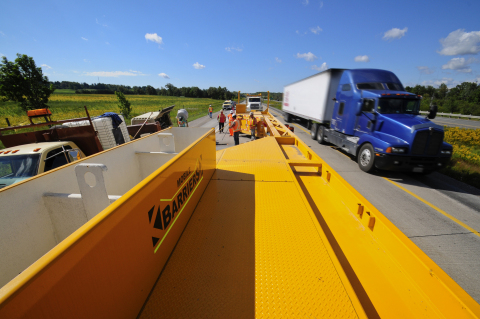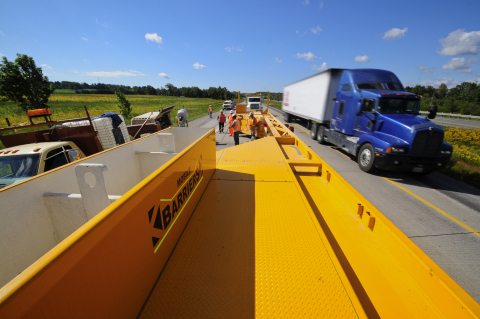DENVER--(BUSINESS WIRE)--Mobile Barriers has released updated 2016 guidance on “Portable Positive Protection” for short duration and short term work zones. Based on work originally prepared by the American Traffic Safety Services Association (“ATSSA”) and the Federal Highway Administration (“FHWA”), the update describes various types of movable barriers (movable concrete, movable steel and highly mobile barriers) as well as protective vehicles particularly useful in short work operations. The 2016 update adds new innovations and resources introduced in the last ten years and updates the footnotes and references.
Highly mobile barriers, one of the devices covered in the guidance, are simply driven in place like a semi-truck to provide longitudinal and lateral (rear and side) protection for short work operations and driven away when the work is complete. One example is Mobile Barriers MBT-1, which can also be used for moving operations. These integrated barriers feature power, lights, signage and TMA, and can carry materials and supplies. They are particularly useful where the work can be broken down into segments of 100’ (30 m) or less.
Movable concrete and steel barriers can be moved from one side of a lane to the other or to the shoulder, as appropriate, when work is complete. They are particularly useful for work zones over 100’.
Protective vehicles, including advanced warning, shadow and barrier vehicles, are used to provide additional motorist warning and longitudinal protection. Protective vehicles can be used in conjunction with other types of portable positive protection, such as highly mobile barriers.
Each can help reduce the number and duration of lane closures, and improve safety and traffic flows in and around work zones.
As TxDOT’s Deputy Executive Director said, “There’s no better way to reduce work zone accidents and improve conditions for everyone than to safely complete the work as quickly as possible and reopen the roadway to normal traffic flow.”
The new Guidance can be found in various places on the web including:
Mobile Barriers is committed to providing safe, efficient work zones and minimizing associated disruption and congestion for the benefit of workers and the traveling public.
To learn more about Mobile Barriers MBT-1, visit www.mobilebarriers.com.




